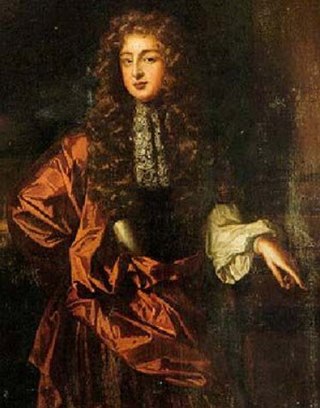James Hamilton, 1st Earl of AbercornPC (S) (1575–1618), was a Scottish diplomat for James VI and an undertaker in the Plantation of Ulster in the north of Ireland.

Claud Hamilton, 1st Lord Paisley was a Scottish nobleman who fought at the Battle of Langside in 1568 for Mary, Queen of Scots. He is the ancestor of the earls, marquesses and dukes of Abercorn.
James Hamilton, 2nd Earl of Abercorn was a Catholic Scottish nobleman. He, his wife, his mother, and most of his family were persecuted by the kirk as recusants. Implementing his father's will, he gave his Irish title of Baron Hamilton of Strabane to his younger brother Claud. His younger brothers inherited his father's Irish lands, while he received the Scottish ones, which he squandered away, being deep in debt in his later days.
George Hamilton, 3rd Earl of Abercorn died unmarried in Padua on a voyage to Rome. He was succeeded by Claud Hamilton, heir of Claud Hamilton, 2nd Baron Hamilton of Strabane, second son of the 1st Earl of Abercorn.
Claud Hamilton, 2nd Baron Hamilton of Strabane was the founder of the Strabane branch of the Hamiltons. He died relatively young at about 32 and his wife, Jean Gordon, married Sir Phelim O'Neill, one of the leaders of the 1641 rebellion, after his death.
James Hamilton, 3rd Lord Hamilton, Baron of Strabane (1633–1655) fought against the Cromwellian conquest of Ireland together with his stepfather Phelim O'Neill. In the Siege of Charlemont of 1650, they defended the fort against Coote, but had eventually to surrender. In 1655 Lord Strabane accidentally drowned in the River Mourne near Strabane, aged about 22 and was succeeded by his brother George.
George Hamilton, 4th Baron Hamilton of Strabane was the younger son of Claud Hamilton, 2nd Baron Hamilton of Strabane. He succeeded to the title in 1655 when his brother drowned while bathing in the River Mourne. After the Restoration, he obtained the return of the family lands around Strabane, which had been confiscated by the Parliamentarians in 1650.

Claud Hamilton, 4th Earl of Abercorn PC (Ire) (1659–1691) was a Scottish and Irish peer who fought for the Jacobites in the Williamite War. He went with King James to Derry in 1689 and tried to negotiate the surrender of the town with Adam Murray. He raised a regiment of horse that he led in the defeats of Newtownbutler in 1689 and Aughrim in 1691. He was killed when the ship that should have brought him to France was intercepted by a Dutch privateer.
Charles Hamilton, 5th Earl of Abercorn succeeded his brother who had been attainted as a Jacobite and, having conformed to the established religion, could get the attainder reversed.

James Hamilton, 6th Earl of Abercorn, PC (Ire), was a Scottish and Irish peer and politician. Appointed a groom of the bedchamber to Charles II after his father's death in battle, he took the Williamite side at the Glorious Revolution and in March 1689 supplied Derry with stores that enabled the town to sustain the Siege of Derry until it was relieved in August. Shortly after inheriting a Scottish and Irish peerage from a second cousin, he was created a viscount in Ireland for his services to the Williamite cause.

James Hamilton, 7th Earl of AbercornPC (Ire) (1686–1744), styled Lord Paisley from 1701 to 1734, was a Scottish and Irish nobleman and peer. An amateur scientist and musician, he published a book on magnetism in 1729 and a treatise on musical harmony in 1730, which was subsequently emended and re-issued by his teacher, Dr. Pepusch.
Sir George Hamilton, 1st Baronet of Donalong and Nenagh, was born in Scotland, but inherited land in Ireland. Despite being Catholic, he served his Protestant brother-in-law, the 1st Duke of Ormond, lord lieutenant of Ireland, in diplomatic missions during the Confederate Wars and as receiver-general of the royalists. He also defended Nenagh Castle against the Parliamentarians during the Cromwellian conquest of Ireland. Hamilton was father of Anthony, author of the Mémoires du Comte de Grammont, of Richard, Jacobite general, and of Elizabeth, "la belle Hamilton".
Colonel James Hamilton was a courtier to Charles II after the Restoration. He appears in the Mémoires du Comte de Grammont, written by his brother Anthony.

Sir Frederick Hamilton was a Scottish soldier who fought for Sweden in the Thirty Years' War in Germany and for the Covenanters in Ireland, Scotland, and northern England. He built Manorhamilton Castle, County Leitrim, Ireland. His son Gustavus became the 1st Viscount Boyne.

Elizabeth, comtesse de Gramont, was an Irish-born courtier, first after the Restoration at the court of Charles II of England in Whitehall and later, after her marriage to Philibert de Gramont, at the court of Louis XIV where she was a lady-in-waiting to the French queen, Maria Theresa of Spain.

Elizabeth Poyntz (1587–1673), known as Lady Thurles, was the mother of the Irish statesman and Royalist commander James Butler, 1st Duke of Ormonde.
John Hamilton, was an Irish army officer of Scottish and Irish origin, who fought in the Williamite war in Ireland on the side of the deposed James II. He died from wounds received at the Battle of Aughrim.

Sir George Hamilton, Comte d'Hamilton was an Irish soldier in English and French service as well as a courtier at Charles II's Whitehall.
Sir Claud Hamilton of Shawfield, PC (Ire), also called of Leckprevick, a younger son of Claud Hamilton, 1st Lord Paisley in Scotland, was a gentleman of the privy chamber of King James VI and I, an undertaker in the Plantation of Ulster, and a privy counsellor in Ireland.
Sir Claud Hamilton was constable of the Fort of Toome in County Antrim, Ulster, Ireland. He is sometimes confused with Claud Hamilton of Shawfield.